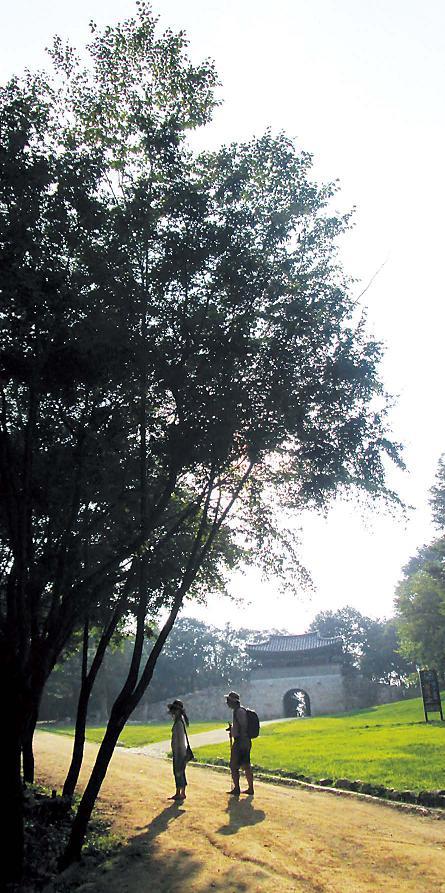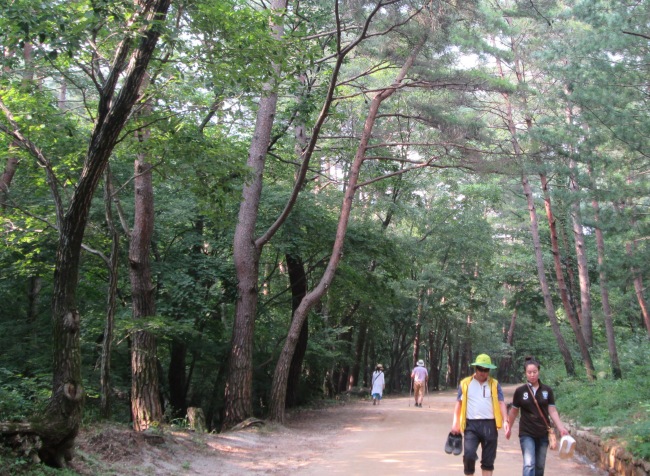This is the eighth installment in an 11-part series that introduces some of the best walking trails in Korea. Based on each trail’s popularity and the recommendations of travel experts and the Culture Ministry, The Korea Herald selected the 10 best places for walking and hiking. The series received funding from the Korea Press Foundation. ― Ed.
Hundreds of years ago, seonbi, literati of the Joseon era (1392-1910), walked hundreds of kilometers from the Gyeongsang region to sit the civil service exam in Seoul.
They would face their biggest obstacle at Mungyeongsaejae, North Gyeongsang Province. The name “saejae” is derived from several features of the place; it means “the peak that is too high that even migratory birds need to take a break,” or “a peak between two steep mountains (Mount Juheulsan and Mount Joryeongsan).”
The gentlemen would stay at a local inn for days, drinking, frolicking in the water and then writing poems expressing the beauty of the village ― all in order to contain their anxiety until they were fully “recharged” to embark on the next leg of the long journey.
It wasn’t only seonbi who took the path. There were governmental messengers, merchants, troubadours and others who took a pause in their journeys and enjoyed the village for some time. Newly appointed government officials to the Gyeongsang region took their entourage through Mungyeongsaejae on a grand inauguration procession.
Today, Mungyeongsaejae is visited by people from around the country seeking a clean, serene and green environment with many folktales, myths and romance.
Ranked No. 1 on a list of 100 places Koreans must visit in 2013 in a joint survey by the Ministry of Culture, Sports and Tourism and Korea Tourism Organization, more than 2 million tourists visited Mungyeongsaejae last year and the figure for this year is expected to be much greater.
Raw but refined
The Mungyeongsaejae 3 Gwanmun (gate) trail is about 6.5 kilometers long, and is composed of the main pathway and several sideways including hiking tracks for Juheulsan and Joryeongsan mountains. Between each gate are trails lined with birch. The roads are dirt tracks, inviting people to take off their shoes and feel nature through the soles of their bare feet ― though it requires some level of patience since little pebbles can make the walk uncomfortable. The local government replenishes the soil on a regular basis, but after heavy rain, the surface is often left with small stones. Pets and bicycles are prohibited to keep the earth clean and hygienic.
Hundreds of years ago, seonbi, literati of the Joseon era (1392-1910), walked hundreds of kilometers from the Gyeongsang region to sit the civil service exam in Seoul.
They would face their biggest obstacle at Mungyeongsaejae, North Gyeongsang Province. The name “saejae” is derived from several features of the place; it means “the peak that is too high that even migratory birds need to take a break,” or “a peak between two steep mountains (Mount Juheulsan and Mount Joryeongsan).”
The gentlemen would stay at a local inn for days, drinking, frolicking in the water and then writing poems expressing the beauty of the village ― all in order to contain their anxiety until they were fully “recharged” to embark on the next leg of the long journey.
It wasn’t only seonbi who took the path. There were governmental messengers, merchants, troubadours and others who took a pause in their journeys and enjoyed the village for some time. Newly appointed government officials to the Gyeongsang region took their entourage through Mungyeongsaejae on a grand inauguration procession.
Today, Mungyeongsaejae is visited by people from around the country seeking a clean, serene and green environment with many folktales, myths and romance.
Ranked No. 1 on a list of 100 places Koreans must visit in 2013 in a joint survey by the Ministry of Culture, Sports and Tourism and Korea Tourism Organization, more than 2 million tourists visited Mungyeongsaejae last year and the figure for this year is expected to be much greater.
Raw but refined
The Mungyeongsaejae 3 Gwanmun (gate) trail is about 6.5 kilometers long, and is composed of the main pathway and several sideways including hiking tracks for Juheulsan and Joryeongsan mountains. Between each gate are trails lined with birch. The roads are dirt tracks, inviting people to take off their shoes and feel nature through the soles of their bare feet ― though it requires some level of patience since little pebbles can make the walk uncomfortable. The local government replenishes the soil on a regular basis, but after heavy rain, the surface is often left with small stones. Pets and bicycles are prohibited to keep the earth clean and hygienic.

“Mungyeongsaejae got its official name in the Joseon era but we assume people to have walked the path long before then,” said Jeong Myung-ja, a local tour guide. Jeong and 22 of her colleagues are appointed by the Mungyeong municipal government to provide the hidden stories behind the trails. The service is available from 10 a.m. through 5 p.m., by calling (054) 550-6392 and making prior arrangements. Currently the guides offer Korean and Japanese services and on special occasions, local English teachers volunteer for English translation.
“In the early 1970s, former President Park Chung-hee visited the region and praised the beauty of the area. He declared that the trail should be left unpaved. Local authorities halted all development plans and instead, gradually worked on preserving the area, green and clean,” Jeong said. Thanks to his announcement, the path and the surrounding areas are organized but still keep the raw beauty of the forest.
Waters including Joryeong stream, Jogok falls and others embellish the all-green scenery, creating a more dynamic space. There is a pond for people to wash their feet after walking the trail without shoes, and small gazebos nearly every 100 meters for walkers to lie down and feel the breeze.
“We have recently received information that otters, which live only in clean environments, have been spotted in the waters at the foot of Mount Joryeongsan. While fishing is not allowed in the waters nearby, animals have been enjoying overhunting,” Jeong said.

Stories in every corner
Due to its steep and dramatic slopes, Mungyeong served as a shelter to early Christians. At the Gidogul, or the praying cave, one can see a Madonna displayed without light or decoration. The tiny space, too little to house more than two people, was a place of exile for Father Thomas Choe Yang-eop (1821-1861), who was the second Korean to become a Catholic priest, and his followers amid severe persecution by the Joseon government trying to eradicate Western ideology including religion. Visitors can still sense the chills and the loneliness that the Catholic believers must have felt back then.
There is also “Sanbuljosim (Prevent forest fire)” engraved on a rock between gates 1 and 2. Believed to have been erected in the Joseon era, scholars consider the engraving to be the only one written purely in Hangeul, or Korean writing, during the Joseon period.

Josan ― literally meaning artificial mountains ― are built near the foot of Mount Juheulsan. The pile of little rocks is believed to replenish energy to places with rather weak energy.
“During the Japanese colonial rule (1910-1945), the Japanese administration rammed stakes into or damaged spots that are said to have good energy according to fengshui. Mungyeongsaejae was no exception and local residents decided to erect josan to replenish the ‘stolen energy,’” Jeong said. Near josan are also piles of small rocks made by visitors and local residents wishing good fortune.
“Had I known this place would be this beautiful I would have definitely been here,” said Choi Sun-hee, a first-time visitor to the region.
“There’s quite a lot of everything here ― good air, clean water, beautiful scenery and even stories at every corner. Who wouldn’t want that?”
How to get there
Buses depart from Central City Bus Terminal (Subway Lines. 3, 7, 9) or Dong Seoul Bus Terminal (Subway Line. 2 Gangbyeon Station) to Jeomchon Station in Mungyeong every 30 minutes. For more information, call (054) 571-0709.
By Bae Ji-sook (baejisook@heraldcorp.com)
-
Articles by Korea Herald



![[Weekender] Geeks have never been so chic in Korea](http://res.heraldm.com/phpwas/restmb_idxmake.php?idx=644&simg=/content/image/2024/05/16/20240516050845_0.jpg&u=)


![[News Focus] Mystery deepens after hundreds of cat deaths in S. Korea](http://res.heraldm.com/phpwas/restmb_idxmake.php?idx=644&simg=/content/image/2024/05/17/20240517050800_0.jpg&u=)
![[Herald Interview] Byun Yo-han's 'unlikable' character is result of calculated acting](http://res.heraldm.com/phpwas/restmb_idxmake.php?idx=644&simg=/content/image/2024/05/16/20240516050855_0.jpg&u=)











